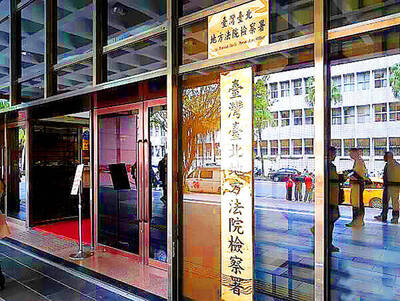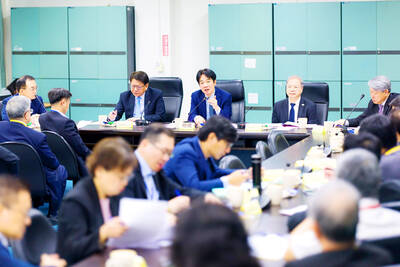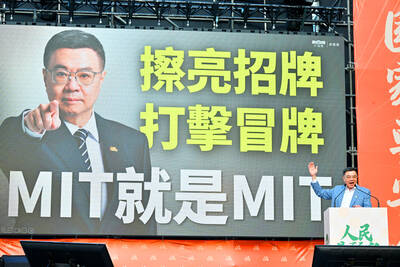Taiwanese officials responded with caution yesterday to a Chinese official’s announcement of a plan to build a rail link between Beijing and Taipei.
Responding to a Xinhua report yesterday in which Chinese Minister of Railways Liu Zhijun (劉志軍) was quoted as saying that Beijing was “actively planning” the rail link, Presidential Office Spokesman Wang Yu-chi (王郁琦) said China would have to take professional and political aspects into consideration.
Wang declined to comment further.
“The railway network is expected to lay a foundation of transport infrastructure for the cross-strait economic zone,” Xinhua quoted Liu as saying.
The rail line may stretch across the body of water between Xiamen, a city in the southeastern Chinese province of Fujian, and Taiwan, the news agency said. It did not specify how trains would cross the 180km Taiwan Strait.
At a separate setting yesterday, Mainland Affairs Council Deputy Minister Liu Te-shun (劉德勳) cast doubt on the need for a cross-strait railroad, saying that both sides of the Strait were making efforts to improve transportation links, including sea, air and postal links.
Regular flights will also be on the agenda at the third session of high-level cross-strait talks scheduled for sometime in the next few months, he said, adding that cross-strait transportation links already had a “solid foundation.”
As China has previously proposed building a freeway to Taiwan, Liu Te-shun said it was necessary for both sides to “shorten the psychological distance.”
He said it was also debatable whether there was any need for a “cross-strait economic zone.”
What mattered more was building a better investment environment and protecting the interests of Taiwanese businesses based in China, Liu Te-shun said.
When approached for comment, Democratic Progressive Party Legislator Huang Wei-cher (黃偉哲) said he opposed the cross-strait railway idea because it would put Taiwan in an unfavorable strategic position.
The railway plan was also illogical, as focusing on air links between Beijing and Taipei would be a better way of improving cross-strait trade ties, Huang said.
Chinese Nationalist Party (KMT) Legislator Chang Hsien-yao (張顯耀) said current transportation links between Taiwan and China and the regular cross-strait charter flights the two nations plan to discuss would be sufficient to satisfy the needs of both sides of the Taiwan Strait.
Building a railway between Taipei and Beijing in a bid to boost cross-strait trade ties would be “uneconomic,” he said.
Regarding the Kinmen County Government’s plan to build a bridge from Kinmen to Xiamen, Liu Te-shun said his understanding was that the Council for Economic Planning and Development had decided “in principle not to build it.”
Wang said the Presidential Office respected the council’s decision.
President Ma Ying-jeou (馬英九) told local residents during his inspection trip to Kinmen on Aug. 24 last year that, although there should not be any technical problem building the proposed Kindeng Bridge (金嶝大橋), he would like them to consider the political implications and effectiveness of building a bridge to China.
ADDITIONAL REPORTING BY FLORA WANG

INVESTIGATION: The case is the latest instance of a DPP figure being implicated in an espionage network accused of allegedly leaking information to Chinese intelligence Democratic Progressive Party (DPP) member Ho Jen-chieh (何仁傑) was detained and held incommunicado yesterday on suspicion of spying for China during his tenure as assistant to then-minister of foreign affairs Joseph Wu (吳釗燮). The Taipei District Prosecutors’ Office said Ho was implicated during its investigation into alleged spying activities by former Presidential Office consultant Wu Shang-yu (吳尚雨). Prosecutors said there is reason to believe Ho breached the National Security Act (國家安全法) by leaking classified Ministry of Foreign Affairs information to Chinese intelligence. Following interrogation, prosecutors petitioned the Taipei District Court to detain Ho, citing concerns over potential collusion or tampering of evidence. The

Seventy percent of middle and elementary schools now conduct English classes entirely in English, the Ministry of Education said, as it encourages schools nationwide to adopt this practice Minister of Education (MOE) Cheng Ying-yao (鄭英耀) is scheduled to present a report on the government’s bilingual education policy to the Legislative Yuan’s Education and Culture Committee today. The report would outline strategies aimed at expanding access to education, reducing regional disparities and improving talent cultivation. Implementation of bilingual education policies has varied across local governments, occasionally drawing public criticism. For example, some schools have required teachers of non-English subjects to pass English proficiency

NEGOTIATIONS: The US response to the countermeasures and plans Taiwan presented has been positive, including boosting procurement and investment, the president said Taiwan is included in the first group for trade negotiations with the US, President William Lai (賴清德) said yesterday, as he seeks to shield Taiwanese exporters from a 32 percent tariff. In Washington, US Trade Representative Jamieson Greer said in an interview on Fox News on Thursday that he would speak to his Taiwanese and Israeli counterparts yesterday about tariffs after holding a long discussion with the Vietnamese earlier. US President Donald Trump on Wednesday postponed punishing levies on multiple trade partners, including Taiwan, for three months after trillions of US dollars were wiped off global markets. He has maintained a 10 percent

TRADE: The premier pledged safeguards on ‘Made in Taiwan’ labeling, anti-dumping measures and stricter export controls to strengthen its position in trade talks Products labeled “made in Taiwan” must be genuinely made in Taiwan, Premier Cho Jung-tai (卓榮泰) said yesterday, vowing to enforce strict safeguards against “origin laundering” and initiate anti-dumping investigations to prevent China dumping its products in Taiwan. Cho made the remarks in a discussion session with representatives from industries in Kaohsiung. In response to the US government’s recent announcement of “reciprocal” tariffs on its trading partners, President William Lai (賴清德) and Cho last week began a series of consultations with industry leaders nationwide to gather feedback and address concerns. Taiwanese and US officials held a videoconference on Friday evening to discuss the